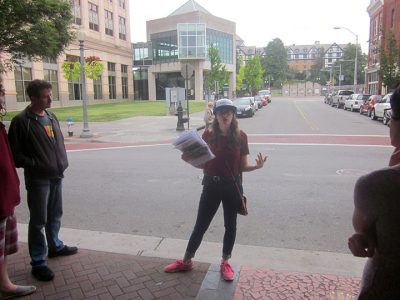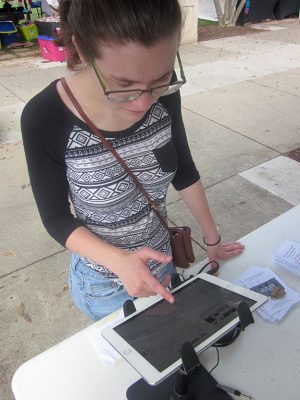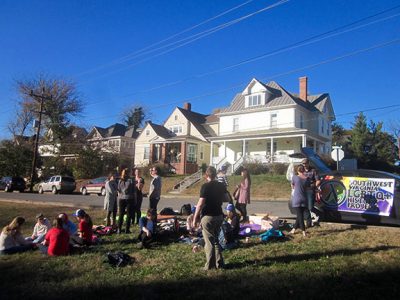Reclaiming queer historical space
02 February 2017 – Gregory Samantha Rosenthal
Editor’s Note: In their article, “Make Roanoke Queer Again: Community History and Urban Change in a Southern City,” which appears in the February 2017 issue of The Public Historian, Gregory Samantha Rosenthal expands upon this preview to explore the intersections among urban history, queer history, and public history. This post will be followed by a series of posts reflecting on this essay and other LGBTQ public history projects. Read the rest of the February issue as well!

Rachel Barton tells the story of transvestite sex workers who used to work on this block in Roanoke, Virginia, as part of the Southwest Virginia LGBTQ+ History Project’s Downtown Roanoke LGBTQ History Walking Tour, September 25, 2016. Photo credit: Gregory Samantha Rosenthal
In September 2016 Politico Magazine published an essay by Colin Woodard detailing the rise, fall, and revival of Roanoke, Virginia, a small city in the foothills of Appalachia that I call home. My friends and colleagues in Roanoke were thrilled when Woodard’s piece was published, sharing it across social media and celebrating the national attention that our small city was receiving. Yet when I read it, I cringed. Just a few paragraphs in, Woodard quotes Dwayne Yancey, editorial page editor at the Roanoke Times: “By the mid-1970s, downtown Roanoke was in sad shape. The old farmer’s market in its heart was a bad place—hookers, transvestites, dealers, all manner of shady characters. Decent people didn’t go there.”
For Yancey, Woodard, and so many of my neighbors, the story of Roanoke’s urban renaissance requires them to make three interrelated historical claims about the city’s past: one, that there was a time when Roanoke was a great place; two, that it later declined (in the 1970s it was in “sad shape”; a “bad place”; full of “shady characters”); three, that the recent arrival of entrepreneurs and the investment of capital into downtown is making this city great again. It is a periodization all too familiar to those of us who just watched a man win the White House through a quixotic campaign to “make America great again.” Things were great, then they got bad, and now they’ll get better. Many people in Roanoke agree with Yancey’s narrative that downtown Roanoke was a “bad place” in the 1970s, and many feel the same way about other American cities in the 1960s, 1970s, and 1980s. But was it really that bad? Bad for whom?
Andrew Hurley has shown how historic preservationists in the United States often seek to return buildings and streetscapes to a mythic “golden age,” leapfrogging the mid to late twentieth-century period of urban decline and top-down urban renewal. This “golden age” mentality allows preservationists to neglect the histories of people who actually inhabited inner cities in their peak years of fiscal insolvency, rising crime rates, and crumbling infrastructure. These were largely people of color, immigrants, poor people, and even “hookers” and “transvestites,” the same groups that Yancey and Woodard contrast with “decent people” in their version of Roanoke’s past.

Roanoke College Work-Study Research Assistant Haleigh Ardolino tests out the technology for presentation of a digital exhibition at the Southwest Virginia LGBTQ+ History Project’s booth at the Pride in the Park festival, September 11, 2016. Photo credit: Gregory Rosenthal
In September 2015 I helped cofound the Southwest Virginia LGBTQ+ History Project, a community-based public history initiative. We started by collecting archival materials and conducting oral histories with members of the local LGBTQ community. In 2016 we expanded our mission to include interpretive programs. We developed a Downtown Roanoke LGBTQ History Walking Tour and launched an online exhibition on the history of gay liberation in Roanoke. Through our ongoing research, we have learned quite a bit about the “hookers” and “transvestites” who were given such brief mention in Woodard’s article.
In the late 1970s, the Roanoke City Council and the Roanoke Police Department combined efforts to target transvestite sex workers in the downtown market area. The Roanoke Times derisively referred to the trans sex workers as “market queens.” In September 1977, the city council proposed an ordinance that would have banned all perceived cross-dressing in public, effectively criminalizing transgender people. One op-ed writer for the newspaper in 1978 described an “all out war on prostitution” that would inevitably lead to “hordes of destitute prostitutes being driven from the market with all their worldly possessions on their backs.” He imagined that “behind these bedraggled ladies of the evening come policemen mounted on horses. . . . It is their job to herd this strange entourage to another place.”
With this colorful language, the author foresaw what would actually take place. By the mid-1980s, police repression had successfully pushed trans sex workers to less desirable real estate in the city, namely industrial areas several blocks east and west of downtown. In the early 1990s, the police renewed their “all out war” on sex workers. At that time, a black transvestite sex worker who had been arrested on trumped-up charges sixteen times in just one year decided that they had had enough of the police harassment. In 1993, representing themself in court, they challenged Roanoke’s anti-solicitation law and won. It was a rare and surprising victory for those undesirable people—LGBTQ folks; people of color; sex workers—whom city leaders, police, and the media had tried for so long to banish from our city streets.
It follows, then, that the narrative of Roanoke’s renaissance is fundamentally tied to the elimination of LGBTQ people from public space. This has proved a key component of downtown gentrification. The erasure of queer and trans people from choice urban properties has been hailed as a victory by civic leaders intent on marketing downtown real estate. To tell the story of a city renewed, queer and trans people stand in for all that was once “bad.” LGBTQ people are employed as symbols of the city’s fall from grace. Making Roanoke great again therefore means preventing gay men from openly cruising and trans sex workers from making a living.

Attendees gather in a field at Highland Park in Roanoke, Virginia, to recreate a “lesbian frisbee” event held thirty-three years earlier by the organization First Friday, November 13, 2016. This is part of a series of historical reenactments that the Southwest Virginia LGBTQ+ History Project has begun to organize on a monthly basis. Photo credit: Gregory Samantha Rosenthal
We in the Southwest Virginia LGBTQ+ History Project like to flip this story on its head. We believe that LGBTQ people have always made Roanoke great. Rather than circumscribe public displays of our diverse genders and sexualities, we seek to “make Roanoke queer again” by returning to the parks where men cruised, to the gay bars that are now condominiums, to the street corners where trans sex workers once fought the police. We seek to raise the queer historical consciousness of our neighbors. We strive not only to claim inner-city space as historical, but to claim it as queer. And we do this not only by telling stories about the queer past, but by telling those stories in public. Whereas gentrification has led to the erasure of queer spaces, our public history project is directing attention back to those places and reclaiming them as part of a new narrative of local history. We do this public history work because we want our friends and neighbors—from the police department to the mayor’s office to the writers at the Roanoke Times—to know that this city is queer. And we’re not going anywhere.
~ Gregory Rosenthal is an assistant professor of public history at Roanoke College and cofounder of the Southwest Virginia LGBTQ+ History Project.




Gregory thanks for helping raise awareness on the diversity in Roanoke’s Transgender and LGB history and it’s sometimes discriminatory perception; and pointing out that the “making things great again” mythology does not equate to slandering and eliminating diversity past or present <3 <3